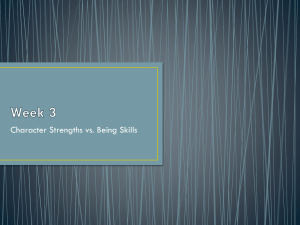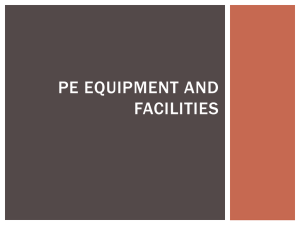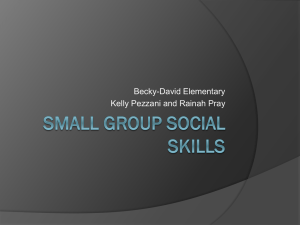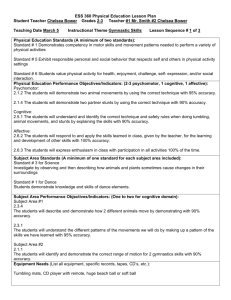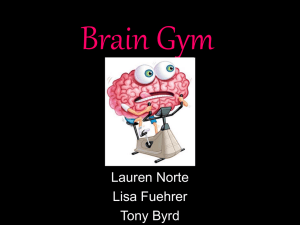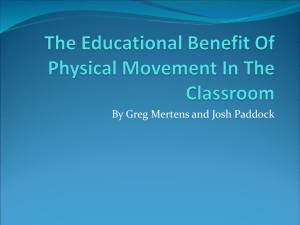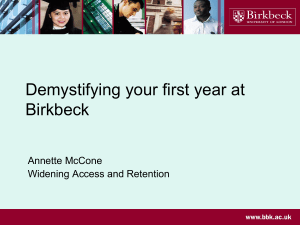Brain Gym - ourstoryoflove
advertisement
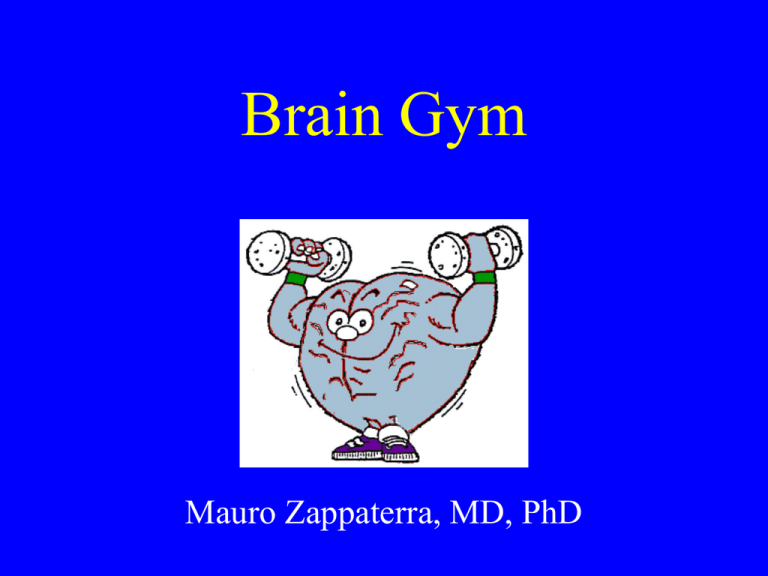
Brain Gym Mauro Zappaterra, MD, PhD Goals • Introduction to Brain Gym • Brain Gym exercises • Have you ever been so stressed that you feel you can’t make decisions? • Or so frustrated that you feel your mind is blocked? • Or just so tired that you just can’t think? Brain Gym may help you overcome these blocks. Brain Gym • Turn your head to the left. – Notice how far you can go and if any tension. • Turn your head to the right. – Notice how far you can go and if any tension. • Massage your ears by unrolling them beginning at the top going to the bottom. – Repeat massage 3 times. • Repeat head turns to assess any difference. What is Brain Gym? • Brain Gym is a program of 26 physical movements to integrate the body and mind which enhance learning and performance. During intense learning and stress certain parts of the brain can shut down and communication between the brain hemispheres can become blocked. Brain Gym Movements Help to Interconnect the Brain in All Dimensions • All parts of the brain work together for more effective learning. Applications • To prepare the learner to learn. • During times of stress and frustration. • To calm the nervous system and energize the body. • To increase blood flow to the brain. Brain Gym Exercises • Cross Crawl Brain Gym Exercises • Hook-ups Cross ankles. Extend arms out in front thumbs down, cross one wrist over the other, interlace fingers and draw hands under and up toward chest. Put tongue on the roof of the mouth and be with a relaxed breathe for a minute or more until emotions subside. Place fingertips of both hands together and put feet flat on the floor for another minute or so. Brain Gym Exercises • Figure 8’s Brain Gym developed by Dr. Paul Dennison • Started working with “learning disabled” students. • Found deficits in physical abilities that affected development which affected learning. • Found that these children did not have an innate understanding of their bodies and how they move in space. • Movements were unnecessary and un-coordinated. • Repeated movements that were comfortable and familiar. Known For Centuries: Movement Enhances Learning • Physical movements contribute to brain development and learning in babies and young children. “Movement is the Door to Learning” • Encouraged his students to discover new ways to move that were more functional and coordinated. • Through movement, he opened the door to learning. Human Brain Function in 3-D • Laterality – coordinate right and left sides of the brain • Focus – coordinate front and back • Centering – coordinate top and bottom Fundamental “Laterality” Skills: Visual, Auditory, Kinesthetic • • • • • Reading Writing Listening Speaking Fluid whole body movements • Simultaneous moving and thinking Fundamental “Focus” Skills • Comprehension • Ability to find personal meaning in experiences • Ability to understand new information in terms of previous experience Fundamental “Centering” Skills • Organization • Grounding • Feeling and expressing emotions • Sense of personal space • Rational thoughts and reactions Brain Function Improves • • • • • • Learn faster and easier Increase creativity Remain focused Remain alert Stay relaxed And just plain feel better about ourselves Brain Gym • Academic skills - reading, writing, spelling and math • Memory, concentration and focus • Communication skills • Organization • Personal stress management • Language development • Physical coordination and balance The Brain Gym Premise • Learning is a natural, joyous activity that continues throughout life. • Learning blocks are simply an inability to move through the stress and uncertainty of a new task. • We are all learning-blocked to the extent that we have been conditioned to inhibit our movements. Brain Gym • • • • Safe Simple and easy to learn For almost any age group Adapts easily for use in the classroom, in tutorials, in the office, on the wards! • Reinvigorates your system in a few minutes
